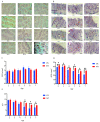Melatonin Promotes the Development of Secondary Hair Follicles in Adult Cashmere Goats by Activating the Keap1-Nrf2 Signaling Pathway and Inhibiting the Inflammatory Transcription Factors NFκB and AP-1
- PMID: 36834812
- PMCID: PMC9964152
- DOI: 10.3390/ijms24043403
Melatonin Promotes the Development of Secondary Hair Follicles in Adult Cashmere Goats by Activating the Keap1-Nrf2 Signaling Pathway and Inhibiting the Inflammatory Transcription Factors NFκB and AP-1
Abstract
Exogenous melatonin (MT) has been used to promote the growth of secondary hair follicles and improve cashmere fiber quality, but the specific cellular-level mechanisms involved are unclear. This study was carried out to investigate the effect of MT on the development of secondary hair follicles and on cashmere fiber quality in cashmere goats. The results showed that MT improved secondary follicle numbers and function as well as enhanced cashmere fiber quality and yield. The MT-treated goat groups had high secondary-to-primary ratios (S:P) for hair follicles, greater in the elderly group (p < 0.05). Antioxidant capacities of secondary hair follicles improved fiber quality and yield in comparison with control groups (p < 0.05/0.01). Levels of reactive oxygen and nitrogen species (ROS, RNS) and malondialdehyde (MDA) were lowered (p < 0.05/0.01) by MT. There was significant upregulation of antioxidant genes (for SOD-3; GPX-1; NFE2L2) and the protein of nuclear factor (Nrf2), and downregulation of the Keap1 protein. There were significant differences in the expression of genes for secretory senescence-associated phenotype (SASP) cytokines (IL-1β, IL-6, MMP-9, MMP-27, CCL-21, CXCL-12, CXCL-14, TIMP-1,2,3) plus their protein of key transcription factors, nuclear factor kappa B (NFκB) and activator protein-1 (AP-1), in comparison with the controls. We concluded that MT could enhance antioxidant capacity and reduce ROS and RNS levels of secondary hair follicles through the Keap1-Nrf2 pathway in adult cashmere goats. Furthermore, MT reduced the expression of the SASP cytokines genes by inhibiting the protein of NFκB and AP-1 in the secondary hair follicles in older cashmere goats, thus delaying skin aging, improving follicle survival, and increasing the number of secondary hair follicles. Collectively, these effects of exogenous MT enhanced the quality and yield of cashmere fibers, especially at 5-7 years old.
Keywords: AP-1; Keap1; NFκB; Nrf2; cashmere; melatonin; secondary hair follicles.
Conflict of interest statement
The authors declare no conflict of interest.
Figures











Similar articles
-
Melatonin promotes secondary hair follicle development of early postnatal cashmere goat and improves cashmere quantity and quality by enhancing antioxidant capacity and suppressing apoptosis.J Pineal Res. 2019 Aug;67(1):e12569. doi: 10.1111/jpi.12569. Epub 2019 Apr 3. J Pineal Res. 2019. PMID: 30861591
-
Melatonin promotes the development of the secondary hair follicles by regulating circMPP5.J Anim Sci Biotechnol. 2023 Apr 7;14(1):51. doi: 10.1186/s40104-023-00849-w. J Anim Sci Biotechnol. 2023. PMID: 37024982 Free PMC article.
-
Effects of melatonin administration to cashmere goats on cashmere production and hair follicle characteristics in two consecutive cashmere growth cycles.Domest Anim Endocrinol. 2021 Jan;74:106534. doi: 10.1016/j.domaniend.2020.106534. Epub 2020 Aug 4. Domest Anim Endocrinol. 2021. PMID: 32861956
-
Melatonin's Role in Hair Follicle Growth and Development: A Cashmere Goat Perspective.Int J Mol Sci. 2025 Mar 21;26(7):2844. doi: 10.3390/ijms26072844. Int J Mol Sci. 2025. PMID: 40243438 Free PMC article. Review.
-
Deciphering the molecular drivers for cashmere/pashmina fiber production in goats: a comprehensive review.Mamm Genome. 2025 Mar;36(1):162-182. doi: 10.1007/s00335-025-10109-z. Epub 2025 Feb 4. Mamm Genome. 2025. PMID: 39904908 Review.
Cited by
-
Melatonin and the Skin: Current Progress and Perspectives for Human Health.J Invest Dermatol. 2025 Jun;145(6):1345-1360.e2. doi: 10.1016/j.jid.2024.11.012. Epub 2025 Feb 6. J Invest Dermatol. 2025. PMID: 39918482 Review.
-
Maternal Melatonin Contributes to Offspring Hair Follicle Development Through Transcriptional Regulation of the AP-1 Complex and MAPK Pathway.Int J Mol Sci. 2025 Feb 24;26(5):1952. doi: 10.3390/ijms26051952. Int J Mol Sci. 2025. PMID: 40076576 Free PMC article.
-
Age-Related Variations in the Population of Active Secondary Hair Follicles, Oxidative Stress and Antioxidant Parameters in Cashmere Goats.Animals (Basel). 2024 Apr 30;14(9):1350. doi: 10.3390/ani14091350. Animals (Basel). 2024. PMID: 38731354 Free PMC article.
-
Melatonin regulates rabbit sperm motility and kinematics via the MT1/PKC signaling pathway.Anim Biosci. 2025 May;38(5):929-940. doi: 10.5713/ab.24.0593. Epub 2025 Feb 27. Anim Biosci. 2025. PMID: 40045627 Free PMC article.
-
Gray Hair: From Preventive to Treatment.Clin Cosmet Investig Dermatol. 2025 Jun 17;18:1475-1494. doi: 10.2147/CCID.S526263. eCollection 2025. Clin Cosmet Investig Dermatol. 2025. PMID: 40546989 Free PMC article. Review.
References
-
- Duan C., Xu J., Zhang J., Zhang W., Sun Y., Jia Z. Effects of melatonin implantation on cashmere growth, hormone concentrations and cashmere yield in cashmere-perennial-type Liaoning cashmere goats. Anim. Prod. Sci. 2016;57:60–64. doi: 10.1071/AN15183. - DOI
-
- Duan C., Xu J., Sun C., Jia Z., Zhang W. Effects of melatonin implantation on cashmere yield, fibre characteristics, duration of cashmere growth as well as growth and reproductive performance of Inner Mongolian cashmere goats. J. Anim. Sci. Biotechnol. 2015;6:1–6. doi: 10.1186/s40104-015-0023-2. - DOI - PMC - PubMed
-
- Zhang C.Z., Sun H.Z., Li S.L., Song D., Zhang C.H., Jin J., Antonini M., Zhao C.F. Effects of photoperiod on nutrient digestibility, hair follicle activity and cashmere quality in Inner Mongolia white cashmere goats. Asian Austral. J. Anim. 2019;32:541. doi: 10.5713/ajas.18.0154. - DOI - PMC - PubMed
MeSH terms
Substances
Grants and funding
LinkOut - more resources
Full Text Sources
Research Materials
Miscellaneous

